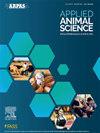Evaluation of antimicrobial activities of probiotic bacterial culture supernatants against liver abscess-causing bacterial pathogens
IF 1.5
Q3 AGRICULTURE, DAIRY & ANIMAL SCIENCE
引用次数: 0
Abstract
Objective
The objectives of our study were to evaluate the abilities of probiotic bacterial culture supernatants to inhibit the liver abscess-causing pathogens Fusobacterium necrophorum, Trueperella pyogenes, and Salmonella enterica in pure cultures or in an in vitro rumen simulating batch culture of rumen microbial model.
Materials and Methods
Probiotic bacterial species were cultured, centrifuged, filter sterilized, and stored at −20°C. Liver abscess-causing pathogens were cultured in anaerobic brain-heart infusion broth (for Fusobacterium) and in Muller-Hinton broth (for S. enterica and T. pyogenes), each with and without probiotic culture supernatants. Bacterial growth was measured in a spectrophotometer or by spread-plating on blood agar, or both.
Results and Discussion
Only the supernatant of L. helveticus reduced the growth of both Fusobacterium subspecies, T. pyogenes, and S. enterica. Addition of L. helveticus supernatant to in vitro batch culture of rumen microbes containing ruminal fluid, buffer, and substrates (glucose, lactic acid, or ground cattle feed) exhibited reduction in the spiked culture of F. necrophorum.
Implications and Applications
Probiotic cultures, such as L. helveticus, may have potential for use as a feed supplement to control liver abscesses.
益生菌培养上清液对肝脓肿致病菌抑菌活性的评价
目的研究益生菌培养上清液对肝脓肿致病菌坏死性梭杆菌、化脓性真芽孢杆菌和肠炎沙门氏菌的抑制作用,并在体外模拟瘤胃微生物模型的间歇培养中进行研究。材料与方法益生菌种培养、离心、过滤灭菌,保存于- 20°C。肝脓肿致病菌分别在厌氧脑-心灌注肉汤(针对梭杆菌)和Muller-Hinton肉汤(针对肠链球菌和化脓性链球菌)中培养,各有和不含益生菌培养上清液。用分光光度计或在血琼脂上涂布,或两者同时测定细菌的生长情况。结果与讨论只有helveticus上清液能抑制梭杆菌亚种、化脓性乳杆菌和肠链球菌的生长。在体外批量培养含有瘤胃液、缓冲液和底物(葡萄糖、乳酸或牛饲料)的瘤胃微生物中添加L. helveticus上清液,可以减少F. necrophorum的尖刺培养。意义和应用益生菌培养物,如helveticus,可能有潜力用作控制肝脓肿的饲料补充。
本文章由计算机程序翻译,如有差异,请以英文原文为准。
求助全文
约1分钟内获得全文
求助全文

 求助内容:
求助内容: 应助结果提醒方式:
应助结果提醒方式:


